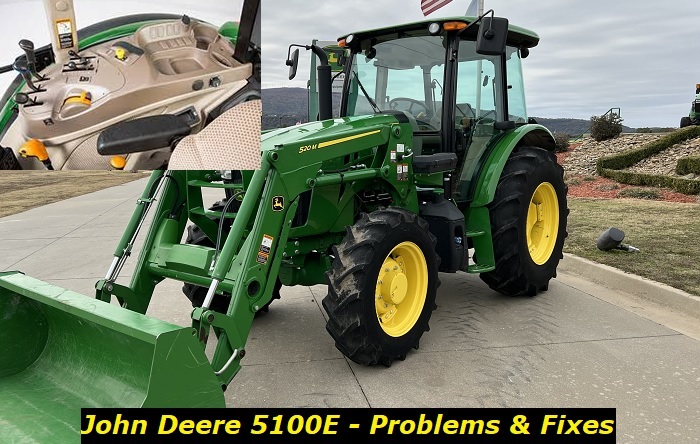John Deere 5100E: Problems, Durability, Repairs
John Deere has consistently scored high in terms of customer loyalty, and that's for a good reason. First of all, its vehicles, especially its utility tractors like the 5100E, are built to deliver under a lot of pressure. Then, they are built with quality and efficiency in mind, which makes them more convenient to use than most of their rivals in the market.
In this article, we will explore the things that you should consider when buying or operating the John Deere 5100E. These include its durability, most common problems, and subsequent repairs.

John Deere 5100E Durability
On average, most tractors can last at least 4,000 operating hours. However, the John Deere 5100E-being known for its resilience-is built to go up to 10,000 hours of work. This is with the consideration that its recommended operating hours and workloads daily are not always exceeded and its regular maintenance schedules are religiously followed.
Most Common Issues in the John Deere 5100E Utility Tractors and How to Repair Them
The John Deere 5100E, as with other products out there, is not impervious to troubles. According to reports, operators, and mechanics, these are the most common problems found in this heavy machinery as well as ways how to repair them:
1. Engine Bogging
When the engine of a John Deere 5100E tractor is bogging, it can be caused by several different factors. The most common reasons are a clogged fuel filter, air in the fuel system, malfunctioning injectors, and/or a faulty pump.
To diagnose the problem and determine its cause, you should observe any noticeable symptoms such as poor acceleration when engaging the throttle, power loss at high speeds, an unusual noise from the fuel tank area, or excessively black exhaust smoke. Examining the fuel lines for obstructions and testing the pressure of each cylinder using special tools can also help pinpoint what is causing the issue.
In most cases, replacing the fuel filter will resolve problems stemming from a clog in the fuel system. If the injectors are malfunctioning, they will likely need to be cleaned or replaced depending on the severity of the problem. If air is detected in the system, it can be bled using a spanner tool and its associated parts such as a compression tube and pressure gauge. Finally, if there is an issue with the pump, it should be checked for proper voltage, amperage, and operation speed before being swapped out for a new one.
2. Transmission Failure
The most common cause of transmission failure in the John Deere 5100E tractor is a lack of maintenance and subjecting the vehicle to its workload limit. If the tractor is not regularly serviced and inspected, transmission components may become worn or damaged over time. This can lead to issues such as slipping gears, difficulty shifting, and even complete failure. If this occurs, it's important to diagnose the problem to determine what components need to be replaced or repaired.
Symptoms that indicate an issue with the transmission of your John Deere 5100E tractor may include clunking sounds when shifting into gear or accelerating, grinding noises when shifting, noise from under the hood during operation, excessive vibration when operating at high speeds, and decreased fuel economy. Visual checks of the transmission components may reveal signs of wear and tear in this instance. Likewise, using tools such as a transmission pressure tester can help diagnose any problems with the hydraulic system and identify parts that need to be replaced or serviced.
If you're experiencing transmission issues on your John Deere 5100E tractor, replacement parts may include new gaskets, seals, oil filters, solenoids, and clutches. If these parts are not easily accessible or cannot be installed correctly by yourself, it is recommended to seek assistance from an experienced technician.
Repairing or replacing any transmission components should always be done carefully and according to manufacturer specifications to avoid further complications. Only use genuine John Deere parts to ensure proper performance and longevity of the tractor.
It is important to note that transmission failure in the John Deere 5100E tractor can often be avoided by keeping up with regular maintenance and servicing as outlined in the product manual. This includes checking fluid levels, inspecting belts and filters, and replacing parts as necessary. Making sure these steps are followed will ensure the reliable operation of your John Deere 5100E tractor over time.
3. Too Much Resistance in Steering Wheel
Too much resistance in the steering wheel of the John Deere 5100E tractor can be caused by worn or damaged components, such as the steering system, linkage, and ball joints. Problems with these components can cause excessive play and difficulty turning the wheels in a certain direction. Next, it is important to check for leaks in the hydraulic cylinders. If a cylinder is leaking fluid, it may affect steering performance and increase resistance in the steering wheel.
For the diagnosis of the issue, you should observe how much effort it takes to turn the steering wheel while driving at various speeds. This will indicate whether there is too much resistance or not. In addition, a visual inspection of all parts of the steering system should take place to identify any damage or wear. Tools such as a dial indicator can be used to test for play in the steering system, and a pressure gauge should be connected to the hydraulic cylinder if fluid is suspected to be leaking.
Once the source of the problem has been identified, it is then necessary to replace any worn or damaged parts. If ball joints are worn, they must be replaced with new ones that meet OEM specifications. The same goes for protection linings, linkage components, and hydraulic cylinders that might need replacement due to damage or leaking fluid. After these parts have been replaced, the steering wheel should operate normally again with minimal resistance when turning the wheels.
It should also be noted that proper maintenance of all components of the steering system is essential to avoid this problem in the first place. Regular inspections and timely replacements of any worn parts can prevent excessive resistance from occurring. Moreover, use only genuine OEM replacement parts to ensure that they meet manufacturer specifications and provide the correct performance and fitment.
Overall, if you experience too much resistance when turning the wheel on your John Deere 5100E tractor, it is important to identify the source of the problem, replace any faulty components, and maintain all steering system items regularly. This should eliminate the issue and allow for proper operation of the steering wheel again.
4. Hard Starts
Hard starts in the John Deere 5100E tractor can be a hassle, but diagnosing and fixing the problem doesn't have to be. The most common causes of starter failure are corrosion on the battery terminals or connections, low battery charge due to insufficient charging, faulty ignition switch, worn out starter solenoid contacts, broken or corroded electrical connections, bad brushes on the starter motor, and failed bearings in the starter motor.
To identify which of these is causing the hard start issue with your John Deere 5100E tractor, take note of any symptoms that may suggest one particular cause over another first. For example, if you hear a loud clicking sound when you turn the key in the ignition switch then it's likely the issue is with the switch itself. If there are no signs of corrosion on any visible connections, then it may be an issue with your battery charge or starter solenoid contacts.
Once you've identified a possible cause based on symptoms, use tools such as a multimeter, ammeter, and voltage regulator to take readings from different components in the system. This will help narrow down which part needs to be replaced or repaired.
For instance, if you measure low battery charge then check the alternator, cables, and connections for breaks or excessive corrosion. If all these seem fine then replace the battery and retest the system to confirm that it's working properly again.
If you identify that your starter motor is at fault, then you may need to replace the brushes, bearings, and/or solenoid contacts. If corrosion is present on the starter motor itself or its connections, then clean it up with a wire brush and use electrical grease to coat the terminal posts before re-connecting them.
Once all these components are replaced or repaired, test your system again before using your John Deere 5100E tractor. With a little bit of detective work, you can get your tractor up and running without too much hassle.
If any part of this process seems overwhelming or confusing, seek out professional help from an experienced technician who can inspect and diagnose any issues more quickly and accurately than you could alone. In any case, paying special attention to each component in the system is important to ensure that your tractor continues to run smoothly and safely.
Conclusion
No matter how good is the John Deere 5100E based on reviews and reports, its regular maintenance that includes diagnosing and fixing its potential issues at their onset should not be neglected. These will save you from further problems down the road and prolong the life of your vehicle to ensure its productivity.

Add comment